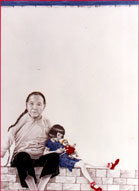
![]()
Search the Journey to Forever website – click HERE
|
Journey to Forever: Make a donation |
Navigation
Contact usTo Keith Addison Handmade Projects |
Sisters of silk
Hong Kong's Chinese Amahs
-- A social research and oral history project for Hong Kong schools to help capture a special part of local history before it fades away.
The Chinese amahs (domestic servants) first gained economic independence through the silk boom in the rural areas of China's Guangdong Province at the beginning of the 20th Century. When the silk boom ended, they formed sisterhoods, took anti-marriage vows, and devoted themselves to domestic service.
Now there are only a few of them left, and the fascinating history of these women and their unique way of life will soon be lost forever.
But children can gather much information from the older generation of their families, and from such details a history can be compiled.
The students will not only be contributing to Hong Kong history but will also build their own history resource instead of relying on others. This is a collaborative project for all levels of pupils.
The project will lead on to rural studies during our journey to see whether this home-based rural industry that boomed worldwide early last century, silk production, can provide sustainable rural employment, especially for women.
Subject areas:
- oral history
- civic education
- social research
- women's issues
- using personal and family networks
- ecology
- IT education
Background
A hundred and twenty years ago much of China's Pearl River Delta north of Hong Kong was a vista of villages and hamlets floating on a sea of fishponds, with a few tiny fields in between. After a lifetime's service they would retire, using their savings to join a vegetarian hall and live out the rest of their days in peace with their sisters. This is a multi-level and multi-disciplinary exercise, with the following components: For secondary grades For all levels Silkworms in a shoebox Eng, R.Y. (1986) Economic Imperialism in China: Silk Production and Exports, 1861-1932. University of California Press, Berkeley.
Fifty years later the land had changed -- half the ponds had been diked, drained and filled with soil, and most of the new land was covered with mulberry trees, producing large crops of white mulberry leaves to feed silkworms.

Drawing by Christine Thery
Half the population was working in China's booming silk industry. And it was the women who harvested the trees, raised the worms and produced all the silk.
The women also did all the reeling, spinning the yellow cocoons into yarn on reels powered by a foot-treadle, working in their homes. There were also hundreds of factories dotted throughout the area, using steam-powered reels to produce silk for export, and all staffed by women. For the first time, rural women in the Delta were well-paid.
Many young silk workers used their new independence to opt out -- they refused to get married, swore oaths of chastity and moved out of their family homes into spinster houses or vegetarian halls.
Many formed sisterhoods, worshipping the chaste goddesses Tin Hau and Kuan Yin. They would even threaten collective suicide to protect one of their number from an unwanted marriage -- and sometimes carry out the threat.
But in the early 1930s the silk industry slumped in the world depression, and many of the women were thrown out of work. Streams of unemployed women silk workers migrated to Hong Kong and Southeast Asia, as labourers, and as mail-order brides, slave girls and prostitutes.
But many took their bonds of sisterhood with them and managed to retain their independence, staying single and working as family domestic servants.
These were the famous Chinese amahs of Hong Kong, Singapore and other Southeast Asian centres, devout, down-to-earth and utterly dependable servants with a style all their own. They brought up generations of Hong Kong's most prominent sons and daughters, who will never forget them.
-- "I've worked for three generations in this family. I have worked for them for 50 years now" -- Leong Ah Hou
This highly personable segment of Hong Kong's culture and history has vanished in the last 20 years -- now "amah" means a Filipina maid.
But there are still some old Chinese amahs left, and some may still even be working for their families, old but capable, and much-loved. Retired amahs are still to be found in vegetarian halls in the New Territories and Lantau Island. A hall attached to a Taoist temple in Mui Wo on Lantau is one of the few places where you can still hear genuine pidgin English spoken.
Not all the women went to the halls. Round the corner from the Handmade Projects headquarters at the Beach House in Pui O on Lantau is a ruined farm where a retired amah named Lui Ying lived in a small cottage, growing vegetables and tending her fruit trees and the ducks swimming in the pond she'd made by damming a stream. There were even a few carp in the pond. She died in the late 1980s. Her grave is in the woods nearby, a peaceful scene.

Chat Suk, our neighbour at the Beach House, is 85, but he still doesn't need spectacles to read his newspaper. His mother used to raise silkworms in their village in Guangdong Province to help the family income. When he was a young boy in the 1920s he helped her gather mulberry leaves to feed the worms. He still has some cocoons -- he keeps them as a good-luck charm, a memento of old times.
There is an old Buddhist shrine on a mountainside in Lantau Island with a stone shrine-keeper's cottage beside it where an old woman lives. She was sold as a child in China and taken to Singapore as a slave girl, but she escaped and returned to Hong Kong. She's lived at the shrine for the last 60 years. She has a really beautiful smile.
The project
Project goal:
Library research
Social research
Subject areas covered
Related projects
Mulberry trees
Kids' crazes
School gardens
References
— (1990) 'Luddism and Labor Protest among Silk Artisans and Workers in Jiangnan and Guangdong, 1860--1930'. Late Imperial China, Vol. 11, No. 2.
Howard, C.W. (1923) The Sericulture Industry of South China. Canton Christian College, Canton.
Howard, C.W. & K.P. Buswell (1925) A Study of the Silk Industry of South China. Ling Nan Agricultural College, Agricultural Bulletin No. 12. The Commercial Press, Hong Kong.
Li, L.M. (1981) China's Silk Trade: Traditional Industry in the Modern World, 1842-1937. Harvard University Press, Cambridge.
So, A.Y. (1986) The South China Silk District: Local Historical Transformation and World-System Theory. State University of New York Press, Albany.
Stockard, J. (1989) Daughters of the Canton Delta: Marriage Patterns and Economic Strategies in South China, 1860--1930. Stanford University Press, Stanford.
Watson, R.S. (1994) 'Girls' Houses and Working Women: Expressive Culture in the Pearl River Delta, 1900--41' in Women and Chinese Patriarchy -- Submission, Servitude and Escape, ed. Maria Jaschok and Suzanne Miers, Hong Kong University Press.